This post contains affiliate links. Please read my disclosures.
This Gluten-Free Shortbread recipe is the melt in mouth buttery biscuit with a touch of crunch that you know and love. A classic Scottish recipe which here uses oat flour, cornmeal and tapioca flour for a wonderful taste and texture with no xanthan gum. It’s incredibly quick to make and so versatile that you can adapt it to endless flavour variations.
The quest for the perfect Gluten-Free Shortbread was not one undertaken lightly. I have an absolute weakness for shortbread and dearly missed it when I switched to a gluten-free diet. Although humble in origin, the beautiful buttery taste of shortbread elevates the confection to a more special status than mere biscuit or cookie.
The right gluten-free flour combination for this particular bake eluded me for a long time. It is often the case that the simpler baked goods can be more tricky to convert into gluten free recipes, especially where regular flour is such an integral part of the recipe with few other ingredients. So I threw myself a mini party when achieving this delicious gluten-free version which produced the perfect shortbread in taste and texture.
Table of contents
- What is shortbread?
- Why you'll love this recipe
- Watch to see how to make it
- Gluten-free flours needed
- How do you make gluten-free shortbread dough without oat flour?
- Full list of ingredients
- Step by step instructions
- Expert tips
- Shop the recipe
- Flavour variations
- Serving suggestions for shortbread
- FAQs
- Other classic gluten-free British recipes:
What is shortbread?
Shortbread is a traditional Scottish confection made with sugar, butter and flour. The earliest printed recipe is credited to a Mrs McLintock in 1736. However, the first versions as a bread dough to which melted butter was added can be traced back to medieval times.
Shortbread needs to have a beautiful buttery taste and a slight bite upfront that gives way to a sandy crumb. In modern versions white rice flour is often included to encourage the crunch. Conversely cornflour is sometimes added to accentuate a soft sandy texture.
Shortbread is so much more than a humble biscuit. In fact its national status as a ‘speciality item of flour confectionary’ was fought vehemently by the Scottish Association of Master Bakers so that it would not be taxed as a biscuit. This simple cookie is often gifted at Christmas in decorative tins and certainly not out of place at high tea.
Why you'll love this recipe
- Tastes just like your favourite classic shortbread with a perfect toasted buttery flavour.
- Soft texture with a touch of crunch and slight crumble
- An easy recipe to make with just 3 gluten-free flours and 4 other simple ingredients.
- Ultra quick. 10 minutes of hands on work then just 30 minutes in the oven.
- No xanthan gum - it's not needed thanks to our carefully chosen blend of gluten-free flours. READ MORE >>> Why I don't bake with xanthan gum
Watch to see how to make it
Gluten-free flours needed
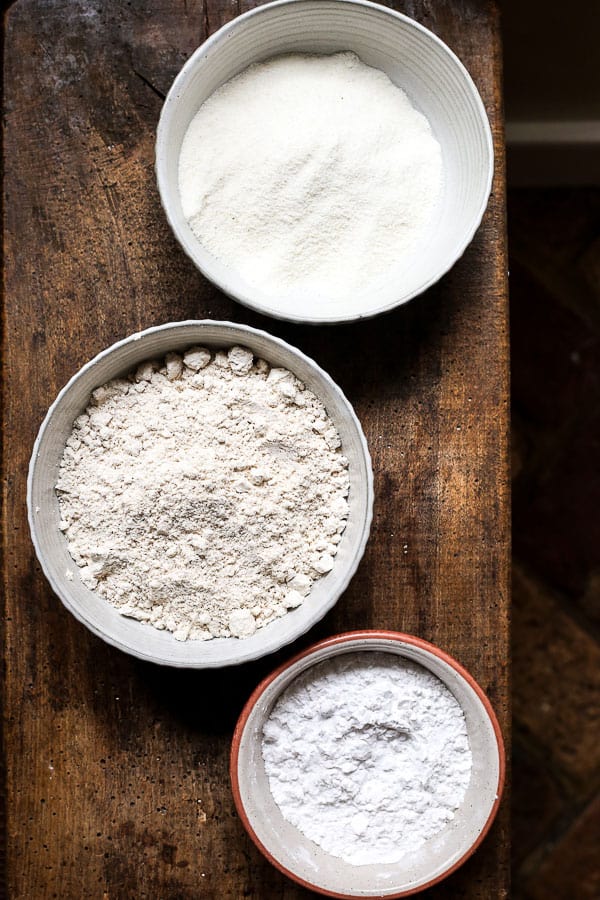
After many recipe tests where the shortbread was either too crumbly, too gummy or not enough bite I eventually discovered the perfect gluten-free flour blend for this recipe which only needs 3 flours:
- Oat flour
- Cornmeal (not cornflour / corn starch)
- Tapioca flour
Oat flour
Gluten-free oat flour is used for its light tender crumb and delicious butterscotch taste which works beautifully with the butter and vanilla.
Oat flour substitution: Usually I might suggest a substitute as even gluten-free oat flour can be difficult to digest for hardcore intolerances. However, if this is the case for you I would like to point you towards a slightly different flour combination (scroll further down to see).
Cornmeal
In regular shortbread the wheat flour can be cut with white rice flour to add crunch. I found without the wheat flour to temper it the white rice flour made the shortbread claggy. Cornmeal is an excellent substitution. I found a very fine white cornmeal which worked well here but any cornmeal will do. The courser the grind though the more definitive the crunch. Note. polenta is a course grind cornmeal
Tapioca Flour
This is the starch we need to stop our shortbread from crumbling apart.
✨Please note. I do not recommend replacing the flours in this recipe for a gluten-free all purpose flour or measure for measure flour as doesn't have the right balance and it won't produce the same results.✨
How do you make gluten-free shortbread dough without oat flour?
If you can’t tolerate oat flour then I recommend a slightly different flour combination. It is just as delicious but the bite of the shortbread is not as short. The recipe and ingredients list are exactly the same except remove the oat flour and tapioca flour. Instead use:
- 175g almond flour
- 150g very fine white cornmeal
Note that this version doesn’t need any starch. The almond flour has enough protein to hold the shortbread together.
Full list of ingredients
- Oat flour
- Cornmeal
- Tapioca flour
- Butter
- Caster sugar
- Vanilla extract
- Salt
Step by step instructions
For full recipe instructions go to the recipe card at the end of this post.
Shortbread is a minimal effort type of bake. It takes about 10 minutes to mix all the ingredients together and only 30 minutes in the oven.
- Beat the butter and sugar until light and fluffy.
- Add the vanilla extract.
- Sift the flours together with the salt then beat in.
- Press the soft dough into a cake tin.
- Bake for 30 minutes.
- Leave to cool completely to room temperature in the tin for an hour before removing onto a wire rack to finish cooling.
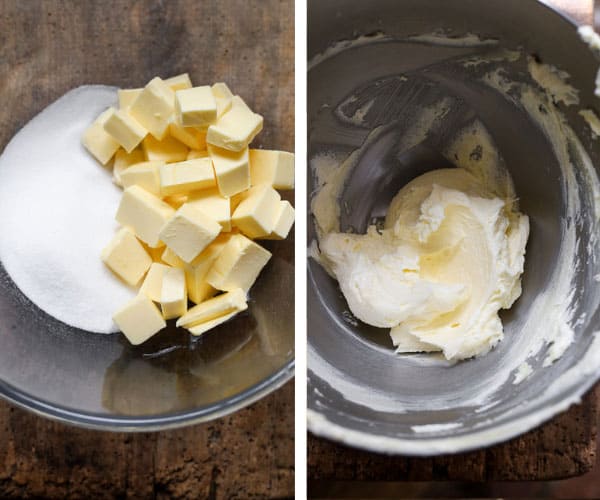
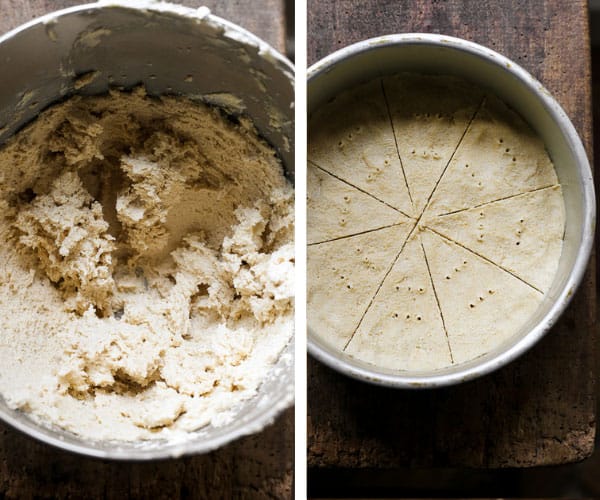
Expert tips
- Use the best unsalted butter you can find. It really makes a difference as this is the overriding flavour of your shortbread.
- Use the best quality vanilla extract. I like Nielsen Massey here.
- Gluten-free shortbread won’t brown too much. This is correct, you want it to be quite pale with a slight nod towards going golden. However if you are using yellow cornmeal rather than white then it will colour slightly more.
- If your scoring has disappeared during the bake then re-score lightly in its tin as soon as it comes out of the oven, be careful as it's very crumbly at this stage.
- Leave the shortbread in the tin as long as possible. I recommend at least an hour but I have been known to place it in its tin straight into the fridge from the oven to cool and remove from the tin a couple of hours later ready to cut.
- Leave the shortbread to cool completely before cutting. Otherwise it has a tendency to crumble. The shortbread will firm up as it cools.
Shop the recipe
 Buy Now →
Buy Now →  Buy Now →
Buy Now →  Buy Now →
Buy Now →  Buy Now →
Buy Now → Flavour variations
Plain unadorned shortbread is delicious as it is but if you wanted to jazz it up slightly then let’s go for it.
Chocolate Caramel Shortbread
Here the shortbread is drizzled with 2 tablespoons melted chocolate, 2 tablespoons dulce de leche and a crumble of sea salt. The dulce de leche is warmed up slightly to make for easy drizzling.
Other ideas
If chocolate and caramel aren’t your thing then there are so many other routes you can go. The earliest versions of shortbread included preserved lemon, orange peel, nuts and caraway seeds. All of which would be delicious. Here are some other suggestions to add to your dough before baking.
- Lemon Shortbread – zest 1 lemon
- Lavender Shortbread – 2 tablespoons of fresh chopped lavender flowers
- Chocolate Chips - a handful of chocolate chips.
- Strawberry Black Pepper Shortbread - 3 tablespoons of freeze-dried strawberry powder and ¼ teaspoon of cracked black pepper.
- Ginger Shortbread – 2 tablespoons diced stem ginger and 1 teaspoon ground ginger.
- Iced Shortbread - Beat 180g icing sugar with the juice of 1 small lemon together and spoon over your cooled shortbread. You can also flavour the icing with any of the flavour variations mentioned above.
Serving suggestions for shortbread
Although an excellent accompaniment to tea or coffee, shortbread can often elevate a dessert. Try serving shortbread alongside:
- Chocolate mousse
- Affogato
- Lemon Posset
- Strawberries and Cream
- Crumbled over ice cream
FAQs
This shortbread is best stored at room temperature in an airtight container and will last up to 5 days.
Absolutely. The easiest way is to can use a rolling pin to roll the cookie dough into a quarter inch thick circle and use your favourite cookie cutters to cut out your preferred shapes. Bake on a parchment-lined baking sheet until golden brown but the baking time will be reduced from the original recipe below.
Other classic gluten-free British recipes:
- Gluten-Free Eccles Cakes
- Gluten-Free Fruit Cake
- Rice Flour Madeira Cake
- Vinegar Cake
- Gluten-Free Victoria Sponge
- Gluten-Free Scones
✨Have you tried this Gluten-Free Shortbread? Please leave a 5-star ⭐️ ⭐️ ⭐️ ⭐️ ⭐️ rating on the recipe card and consider leaving a comment as well! I would love to hear about how your recipe turned out and your feedback also helps other readers✨

Buttery Gluten-Free Shortbread
Ingredients
- 225 g unsalted butter
- 100 g caster sugar
- 1 teaspoon vanilla extract
- 150 g oat flour
- 125 g very fine white cornmeal
- 50 g tapioca flour
- ½ teaspoon salt
Instructions
- Pre-heat the oven to 180°C/160°C fan assisted oven/gas mark 4.
- Line and grease a 20cm (8 inch round cake tin).
- Beat the butter and sugar together for 3-4 minutes until light and creamy.
- Add the vanilla extract and stir to combine.
- Sift together the oat flour, cornmeal, tapioca flour and salt then add to the butter and sugar. Beat until it is fully incorporated.
- Tip the dough into the baking tin and press into the tin using your hands.
- Use a sharp knife to gently score four lines across the diagonal of the shortbread to mark out the intended slices.
- Pierce the surface of the shortbread with the tines of a fork a couple of times to let the air escape.
- Bake for 30 minutes until the top is just starting to turn golden.
- Remove from oven then rest the shortbread for an hour in the tin before removing. Leave to cool completely on a cooling rack before cutting into wedges.
Video
Notes
Can’t have oat flour?
If oat flour is problematic for you then I recommend a slightly different flour combination. The recipe and ingredients list are exactly the same except remove the oat flour and tapioca flour. Instead use:- 175g almond flour
- 150g very fine white cornmeal
Pro tips
- Tip #1 Use good unsalted butter. This is the main taste of your shortbread so you need it to be the best you can find. Organic, unsalted butter direct from the farm if possible. You will notice the difference. (likewise with the vanilla extract)
- Tip #2 If your scoring has disappeared during the bake then re-score lightly in its tin as soon as it comes out of the oven, be careful as it's very crumbly at this stage.
- Tip #3 Leave the shortbread to cool completely before cutting. Otherwise it has a tendency to crumble. The shortbread will firm up as it cools.

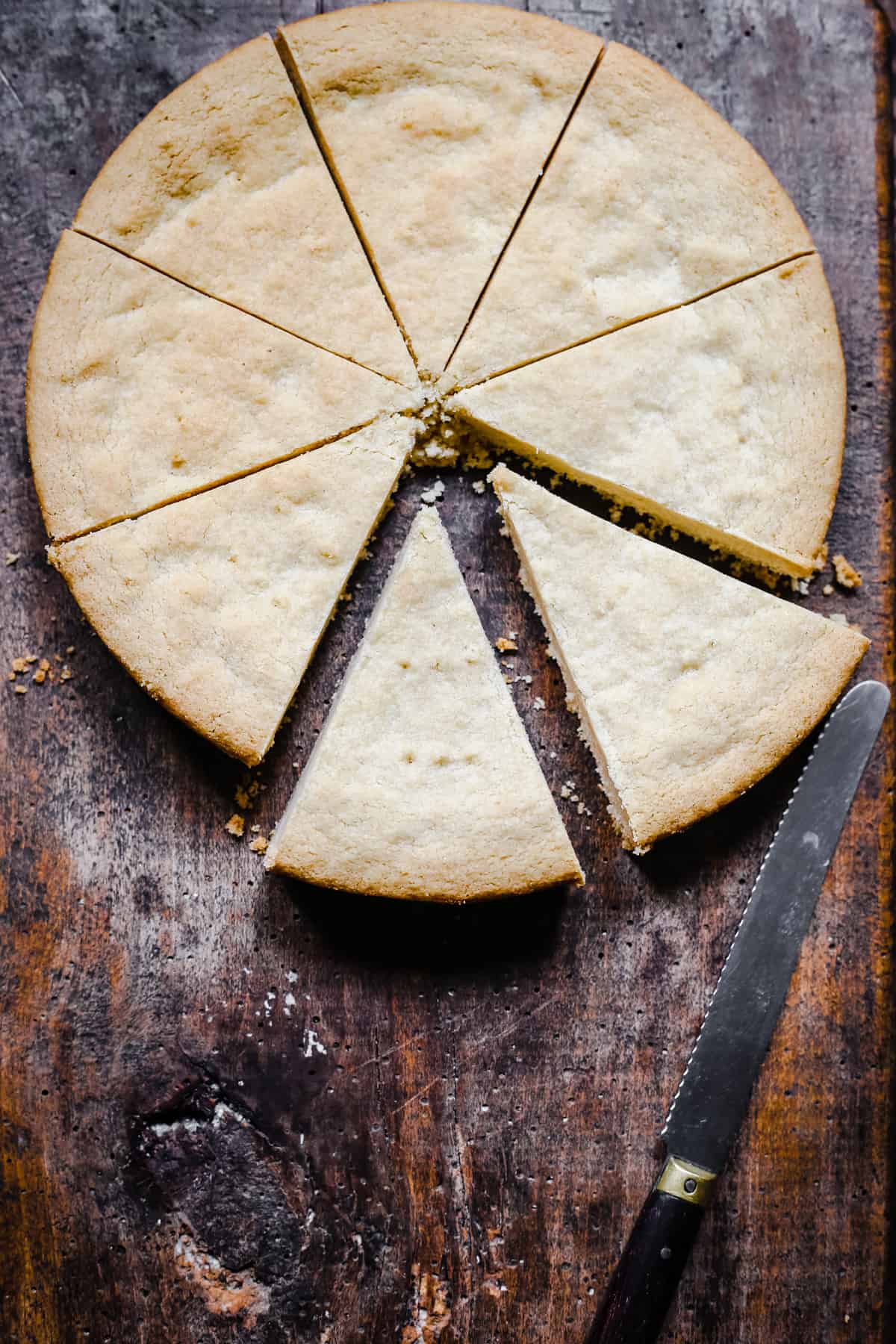
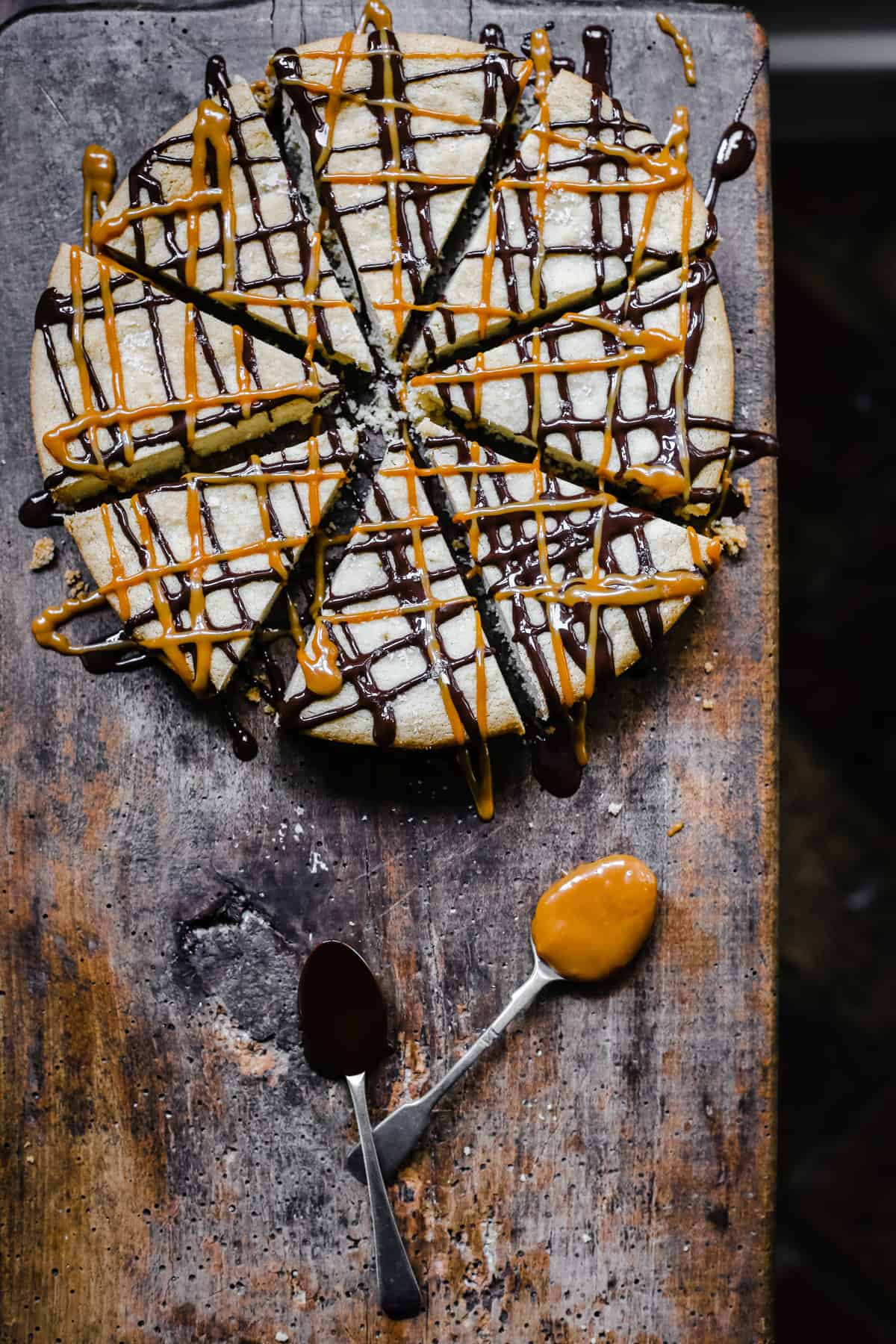
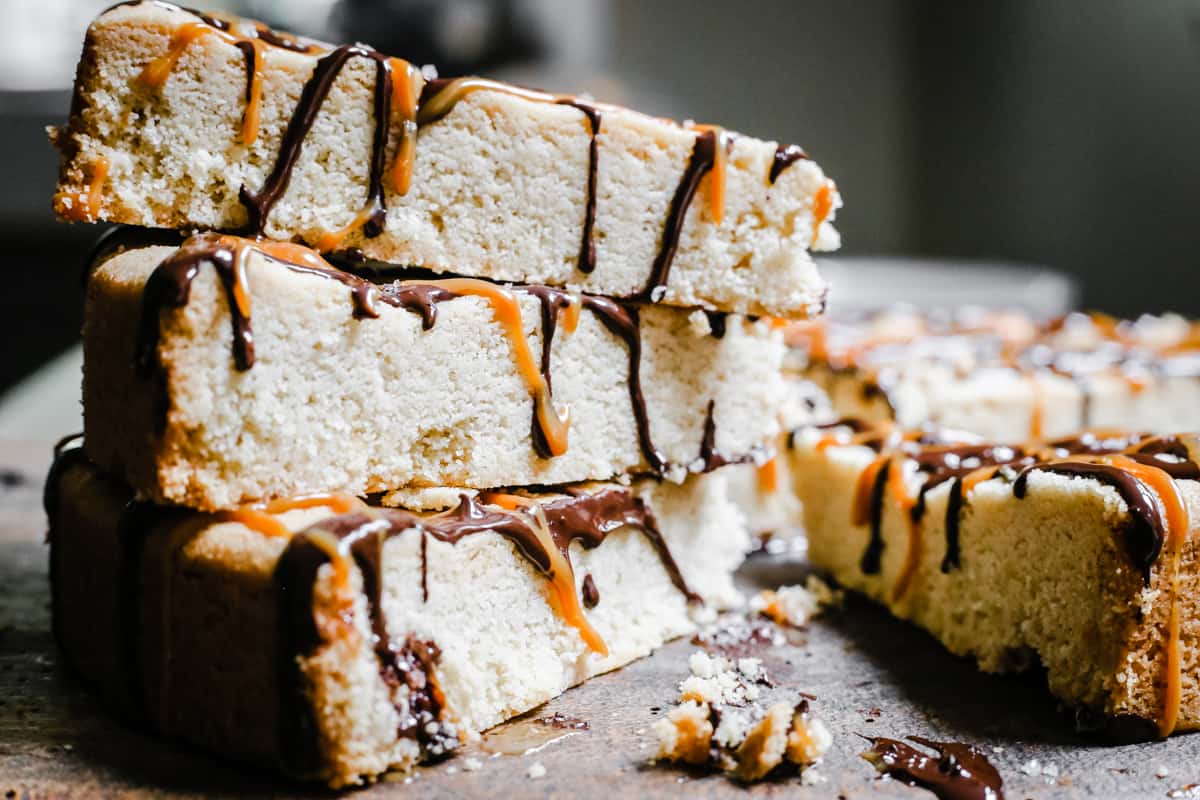

Kathi says
I am at high altitude, Colorado.
Mine came out under cooked. I'm popping it back in for additional time. Hoping it does the trick.
Georgina Hartley says
Let me know how it goes - I have no experience of baking at high altitude so it always interests me how the recipes get on in those parts of the world.